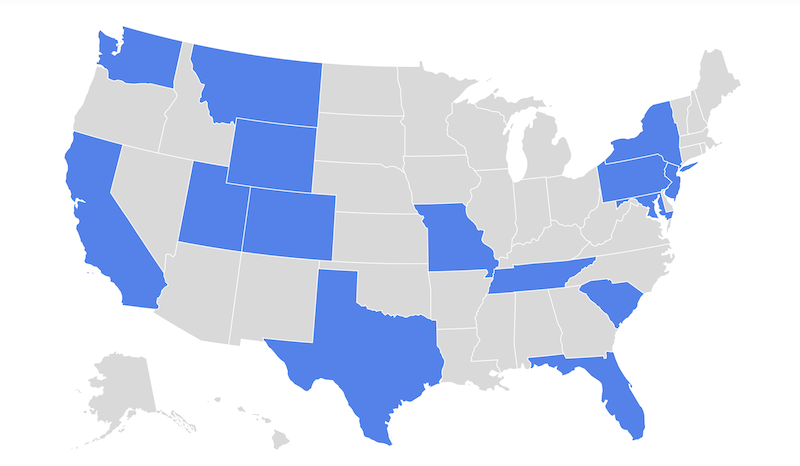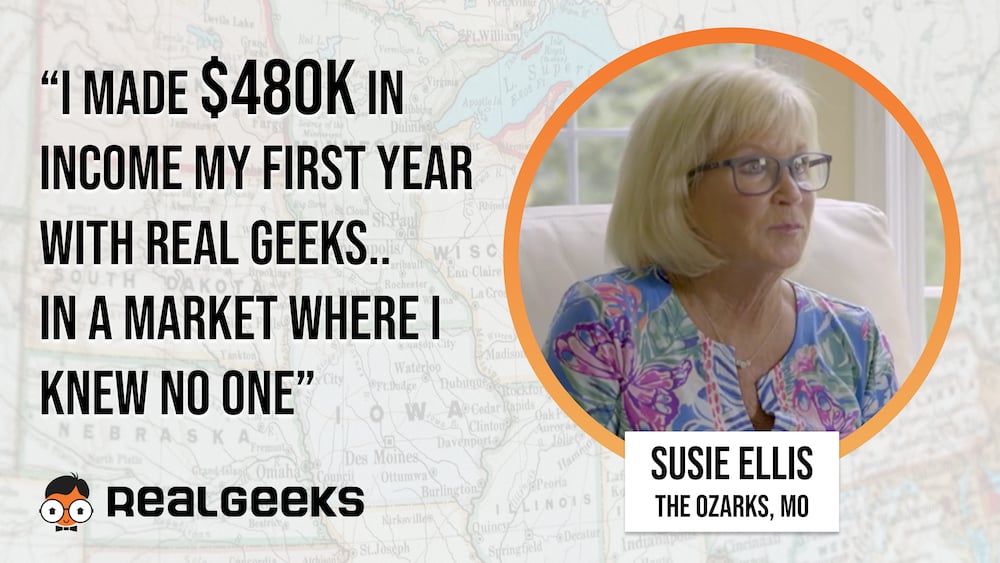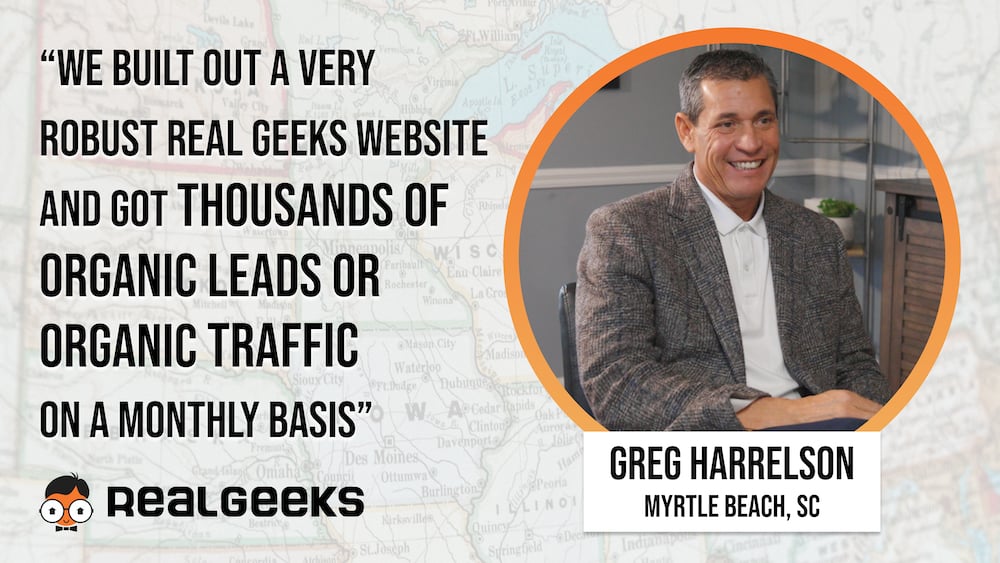
In our latest coaching call with Greg Harrelson, we spoke about the truth of lead conversion numbers across our industry.
If you want to learn first-hand how Greg generates over 1,000 transactions a year completely organically through the Real Geeks system, join his private coaching academy, RGMastery.com, for less than $200/month and no contract fees.
The term "lead conversion" is described in many ways. According to Greg, it should be defined as the number of leads you end up signing a contract with divided by the total number of leads you captured.
But all too often, you'll see real estate agents boosting their numbers and say they have a conversion ratio of 15%. That's off the charts.
"When you see this number, I'm not saying that they're lying. But they're probably calculating that number differently than I am." says Greg.
For example, many agents will calculate it through the total number of leads they sign with divided by the total number of leads they got into a conversation with. Because the bottom number is smaller, the percentage ends up being much higher.
The National Association of Realtor recently published that the average conversion rate is between 0.5% to 1.2%. This means that for every 200 leads you capture, you only convert 1-2 of these into a paying customer.
"Now this is more accurate," says Greg.
But here's the catch: there's a difference between what one agent converts and the leads that end up converting.
This is where the truth lies. More leads from the same pool are converting than an individual agent is converting.
In other words, if an agent captures 100 leads and converts one of them, his conversion rate is 1%. But of the other 99, it's likely that at least one also converted, albeit with another agent.
So we have two numbers here:
- True conversion: the conversion rate of these 100 leads.
- Agent conversion: the conversion rate of this one particular agent within these 100 leads.
Here's another interesting stat Greg brings up:
Out of a random 100 people, on average, 5 of them will purchase a home in a period of 12 months. And in a period of 24 months, another 5 of those 100 will purchase a home.
Over one year, this is a 5% true conversion. Over two years, this is a 10% true conversion.
And still, an agent is converting 1% of those people, on average.
"I did an audit of 5,000 leads. Guess what we found? 12% of those leads converted over a period of 24 months," Greg shares, and adds: "Not all of them converted with us. Many of them converted with our competitors."
While checking Sold.com, Greg looked over a pool of 1,144 leads from a particular region. Over a period of 12 months, 120 had listed or sold. That's nearly 10%.
This number seems to replicate across different sources. Fello is another homebot where Greg checks out reports. And still, 10% of people will buy or sell over a one year period.
"The truth about lead conversion is this: about 10% of the leads are convertible. So what agents need to ask themselves, honestly, what their personal conversion is, and compare it to the actual potential of those leads."
If you're doing 1%, 2%, 3%, it doesn't mean you're doing wrong. These are good numbers. Most people are below 1% right now.
A good converting agent is at 3%. And still – there's room for improvement. Because there's another 7% this agent's missing out on.
Here are a couple of other hard truths:
- Every source converts virtually the same. So you're wasting your time looking for the best lead source. Pick one based on your individual skills, focus on that one, and optimize your activities to get closer to that 10%.
- No agent converts at 10%. At least not based on Greg's definition. This is normal – people will respond better to the approach of different agents. But you probably have a lot of room to improve and get closer to 10%.
"This stuff should inspire you – you can easily get to 4%, 5%, maybe even 6%. But not by changing lead sources. But by optimizing your processes on one source," Greg advises.
So, how do we improve our conversions?
Top producers who are winning more deals are not capturing more leads than you. They're just losing less opportunities.
Something that happens far too often in our industry is this: an agent will engage a lot with a lead as soon as they capture them. But if the lead doesn't transition into a transaction over the first few months of being captured, the agent drops most if not all communication. And just a few months later, the lead ends up converting with another agent, who feels extremely lucky to have converted that lead over the first few months of capturing it.
All that happened here was that the second agent was at the right place, at the right time.
A top producing agent understands this, so they'll never let this happen.
A top producing agent will use automations within their CRM to make the lead feel like they're constantly engaged with, so that when they are ready to buy (perhaps six or seven months after being captured), they'll do it with the same agent.
Let that sink in for a second.
"Top producing agents are not winning more business – they're losing less. They have fewer leads slipping through their fingers and into the CRM of another agent."
So leverage your technology to make sure your leads are always being served, whether they've just been captured, or they were captured 12 months ago.
Greg suggests a list of activities for this purpose. And a great CRM like Real Geeks will have most of these tools already at your disposal.
- Creating and using several Advanced Search Filters
- Crafting multiple 1-2 step Workflows
- Sending Monthly Sold reports
- Sending Monthly Market Activity Reports
- Retargeting
- Advertising on social media with the same or similar audiences that you've captured on your CRM
- Having all day Call Days with leads that are disengaged
- Texting your leads a link to an automatically updated page on your site with the Top 10 Listings to hit their market
So, how do we improve our conversion to get closer to that 10%?
We nurture every single lead through these multiple channels as if we had captured them on that same day.
Speed to Lead, Revised
Greg believes that most coaches aren't talking about Speed to Lead anymore because the concept's been completely misunderstood.
See, we think Speed to Lead means that a bot can get to our leads faster, so we should be automating our responses as much as possible with A.I. or chatbots.
"When I talk to the people who have set all of these bots, I realize their production hasn't really improved in that time."
A.I. and chatbots might sound sexy, but they're far from the activities that are actually going to move the needle forward.
The activities that are really going to make a difference are the ones Greg outlined before.
"Reach your leads faster by calling them," he advises, "I'm not anti-automation – I think automation is great for nurturing a lead over time, but I'm against it being the first thing your leads get from you. I'm anti auto-responding," he states.
Closing Thoughts
We accumulate a lot of leads nowadays. And the more you accumulate, the harder it is to reach them.
How do you choose who to call and who not to call? By using Advanced Search Filters to create smart lists based on how these leads are engaging.
The way that you get closer to that potential 10% conversion is by prioritizing the leads that are engaging at the moment, and by effectively automating communication with the ones that perhaps are not as engaged to get them engaged.
This is how you prevent losing leads and having them move forward with your competitors. It's a delicate balance between manual work and leveraging technology.
Your goal should be to constantly be moving people in your database from an unengaged lead that requires workflows to an engaged lead that is open to being called.
Remember – your conversions are influenced by your processes, not your source. Stop hopping from lead source to lead source and optimize your activities.
And if you need further help with any of this, get it from the man himself at RGMastery.com
Real Geeks is a highly efficient and effective lead generation and conversion solution for cultivating, capturing, and managing leads at any stage of the home buying or selling process.
Drive traffic, capture leads, nurture opportunities, and close more transactions with a robust CRM, fully integrated custom IDX website, and marketing solutions for agents and teams of any size.
Real Geeks is one of the best lead generation and management platforms available, but don't just take our word for it – hear from customers loving their experience with Real Geeks →






/Blog/Thumbnail%20-%20Emerging%20Brokers%20Time%20to%20Build%20Your%20Engine.png)
/Blog/Thumbnail%20-%20Automation%20That%20Frees%20Agents%20to%20Do%20What%20They%20Signed%20Up%20For.png)
/Blog/Thumbnail%20-%20Choice%2c%20Freedom%2c%20and%20the%20Power%20of%20a%20Platform.png)